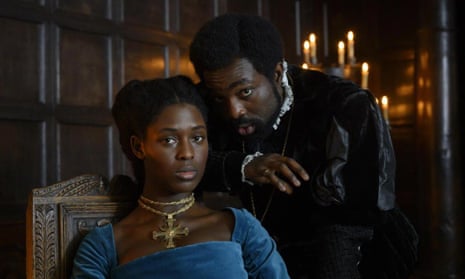If it’s pigs heads on platters, it must be Tudors. And so it is. 1536, to be precise. Opening captions for the new Channel 5 drama Anne Boleyn, stripped across three nights, inform us that Anne has been queen for two and half years, has provided Henry VIII with one daughter, had two miscarriages and is now pregnant again. She is the most powerful woman in England, and she has just five months to live. Dum-dum-DAH!
I added the dum-dum-DAH! Anne Boleyn (the drama) takes itself too seriously for that. This is not The Tudors, this is Proper History and it delivers on all the basics. The caprice of Henry (Mark Stanley). The claustrophobia of court. The power of a misplaced word or a deliberate strike. The power struggles between Cromwell (Barry Ward) and Anne (Jodie Turner-Smith). The quiet progress of the “little mouse” Jane Seymour (Lola Petticrew). The importance of an heir. The horse-trading between countries to secure alliances, and the seven-dimensional chess being played behind the scenes.
Look, it’s not Wolf Hall. Nothing will ever be Wolf Hall again and although its shadow looms large, it looms unfairly and should be banished. On its own terms, Anne Boleyn works well enough. There is too much speaking in extended metaphor (“Even the dearest of lapdogs can bite if left unschooled,” says Anne during anti-Cromwell pillow talk with Henry; Jane Seymour holding the winning hand in a ladies-in-waiting round of cards “doesn’t understand the game”. “Then you really mustn’t play,” says Anne). And dramatic irony is laid on with a trowel. Anne watches, aghast – aghast, I tell you – when grooms slaughter the horse that threw the king at a joust. They cut its throat with a sword and blood spills over the ground. Rather like it would/does when you decapitate a woman who has failed to provide you with a son and heir, you see? In case you don’t, Henry spells it out when she chides him for ordering the death. “She was a fine creature.” “I’ve no use for an animal that won’t obey me.” In case you still don’t, she dreams about the horse later and wakes up in gasping horror at the memory of the blood.
In publicity interviews, series creators Fable Pictures have made it clear that their interpretation of Boleyn is of a strong woman destroyed by a small cabal of men, rather than the unfortunate victim of a swirl of political forces beyond her or any one individual’s control. You could argue that – for a supposed feminist retelling of Anne’s story – screen time is oddly weighted in favour of showing Anne’s sexual hold over Henry (here a mild masochist who has found his gentle sadist) rather than her intelligence, wit or any of the less throttling-based attributes that drew him to her. But the five-months-in-three-parts structure keeps things moving at a clip without sacrificing either detail or comprehension. And holding it together they have a superb Anne in Turner-Smith, every inch the embattled queen, unshakeably regal even as she flashes fire and fury in the wake of Henry’s latest betrayal. You don’t doubt that she came to power. The only real difficulty with her performance is that, especially in the face of an underpowered Henry, you can’t quite believe any of them would have dared to kill her in the end.
Actually, there has been another difficulty with the performance. Turner-Smith’s casting caused a stir because she is of Jamaican descent. If you are someone who is bothered by that, well then you are probably the kind of person who is always going to be bothered by that and we need not detain you here. For what it’s worth, I am aware that Anne Boleyn wasn’t black, but I’m also aware that she wasn’t Claire Foy, Merle Oberon, Helena Bonham Carter or any of the other women who have played her over the years, and my brain is not unduly upset by any of it. What having a person of colour in the role does do, perhaps, is give us a way in to understanding the marginalisation of the Boleyns (Paapa Essiedu, a British actor of Ghanian heritage, plays her ill-fated brother George) at the time. The class, sex and religious prejudices held against them by various factions, and that we have largely lost to time, can be mapped on to the racial prejudice that endures. History repeats itself, but this is television that finds a new way to warn us of that truth.

Comments (…)
Sign in or create your Guardian account to join the discussion